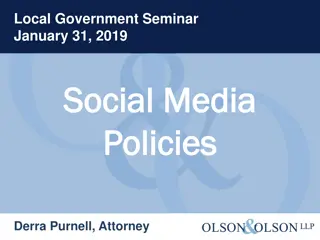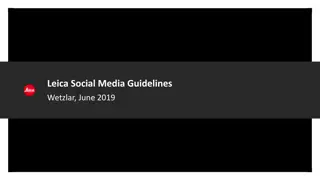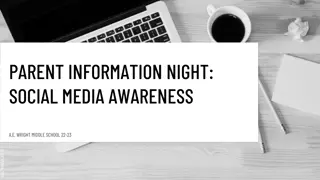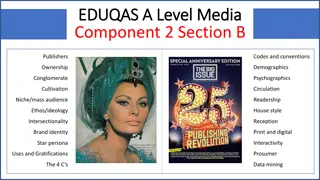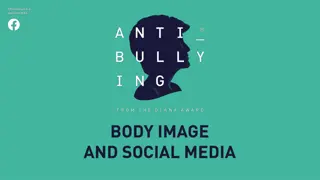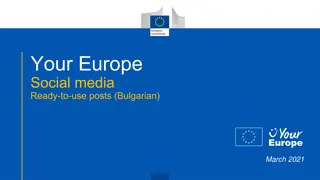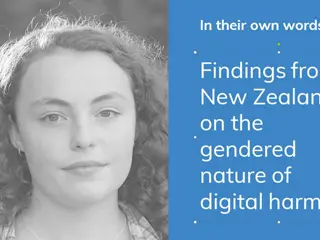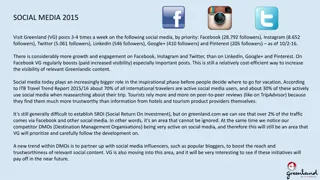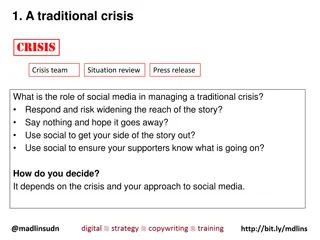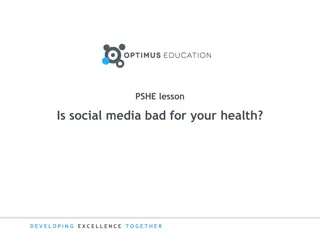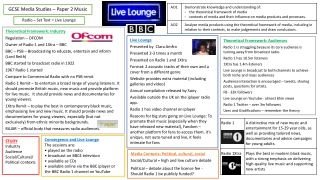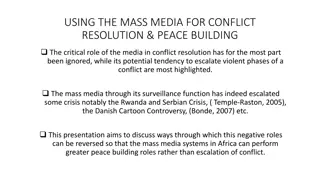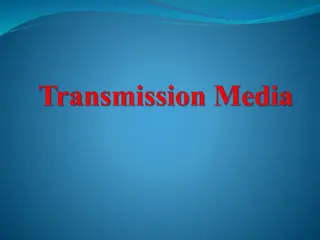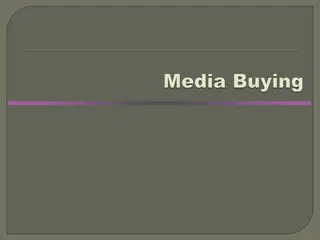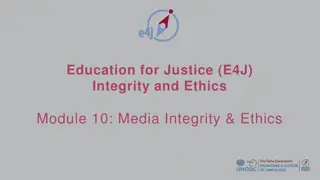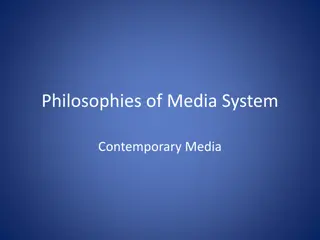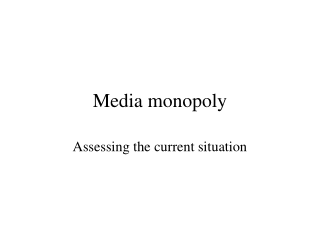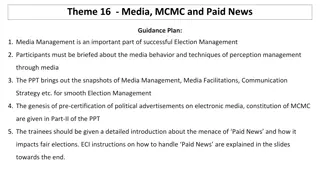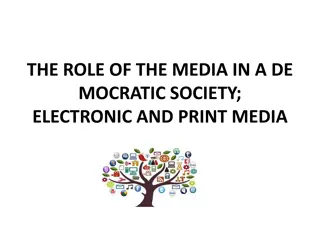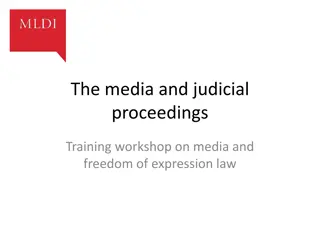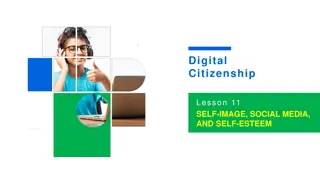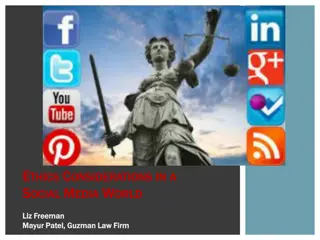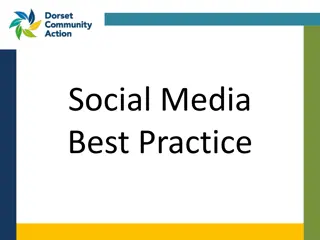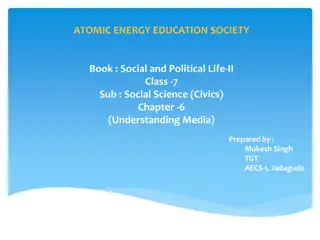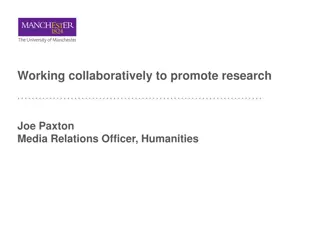Understanding Social Media for Publishers
Social media plays a vital role in today's digital landscape, offering publishers a platform to engage with their audience, promote their content, and drive growth. This module explores the impact and strategies of social networking for publishers, emphasizing the importance of audience-centered communication. With billions of users across various platforms, understanding the dynamics of social media is crucial for publishers aiming to expand their reach and influence in a competitive market.
Download Presentation

Please find below an Image/Link to download the presentation.
The content on the website is provided AS IS for your information and personal use only. It may not be sold, licensed, or shared on other websites without obtaining consent from the author. Download presentation by click this link. If you encounter any issues during the download, it is possible that the publisher has removed the file from their server.
E N D
Presentation Transcript
Social Networking for Publishers Library Publishing Curriculum Impact Module, Unit 7
Social media is a conversation Remember: it s not about you, it s about your stakeholders and audience
Definitions Social Media: websites and applications that enable users to create and share content or to participate in social networking. * Social Networking: the use of dedicated websites and applications to interact with other users, or to find people with similar interests to oneself. * Social Media Marketing: the use of social media to promote or sell products and services. Social Media Strategy: encompasses the ways organizations seek to engage with stakeholders, attract customers, or promote their brand through social media. * https://en.oxforddictionaries.com/definition/social_media, https://en.oxforddictionaries.com/definition/social_networking
Social Network Users: 2.7 Billion by 2018 Source: Statista, 2017
Pace of Growth Has Slowed Recently Source: Pew Social Media Fact Sheet 2017
Facebook Dominates Nearly 80% of adults use Facebook, the most popular social media platform Source: Pew Social Media Update 2016
Most Social Media Users on Multiple Platforms Source: Pew Social Media Update 2016
Social Media as News Source For many users, social media is also the (or a) major source of news Reddit, Facebook, and Twitter are especially popular for news consumption Source: Pew Research Center: News use Across Social Media Platforms 2016
Daily Social Media Use Most Facebook and Instagram users engage with social media daily Source: Pew Social Media Update 2016
Centering audiences and stakeholders
A New Way to Connect Historically, publishers had little direct contact with customers, and almost never a conversation Publishers traditionally focused on the business-to-business relationships to bring books to the market Wholesalers Booksellers Online Retailers
Changing Market, Changing Conversations Transition to digital books and retail channels Loss of shelf space in traditional venues Increased consumer use of social media Technology drives contact and engagement Increased access to consumer data and feedback Rise of spreadable media/participatory culture
Identifying Stakeholders General public Libraries Library admin Consumers Scholars University admin Press ? Past Funders Current Granting agencies Authors/Editors Prospective
Prioritize Stakeholders LEVEL OF INTEREST Low High Keep Satisfied (Medium effort) Manage Closely (Maximum Effort) High POWER Monitor Keep informed (Medium effort) Low (Minimum Effort)
Find Your Stakeholders Connect with audiences on the platforms they already use If resources allow, maintaining multiple social media channels will connect you to different segments of your audience
Facebook Popular among all demographic groups Slightly more popular among women Especially popular among younger adults Source: Pew Social Media Update 2016
Instagram Rapidly growing user base More popular among women than men Highly popular among young adults, especially college-educated urbanites Source: Pew Social Media Update 2016
Pinterest Slowing growth among all groups More popular among women (largest gender gap among the surveyed platforms) Source: Pew Social Media Update 2016 Source: Pew Social Media Update 2016
Twitter User base has leveled off More popular with young adults, especially wealthy, college-educated urbanites Source: Pew Social Media Update 2016
LinkedIn Slightly more popular among men Highest gap of surveyed platforms between college-educated and non-college-educated users Most popular among employed users making over $75K Source: Pew Social Media Update 2016 Source: Pew Social Media Update 2016
Understanding Your Audience Monitor and analyze engagement with your social media channels Use a software such as Hootsuite to identify patterns, track levels of engagement, and manage your social media presence Analyze your target audiences social media behavior Where does your audience already hang out? Who do they already follow? What kind of content do they engage with? What hashtags do they use? Identify influential social media users/channels using tools like SocialMention and Klout
Hearing vs. Listening Hearing: Analyzing the response to your brand or products What are customers saying about your brand and products? Listening: Engaging in conversations about your brand, products and making changes in response to customer feedback How is your organization willing to change based on customers viewpoints or interests?
Learning from Peers Review web presence (including underlying code) and social media platforms of comparable publishers Who follows them? What type of content do they post? What hashtags do they use? What can you learn from their social media strategy?
Aligning Social Media Goals and Channels Tumblr Twitter Pinterest Goodreads Announcements, current events Announcements, current events Engaging with followers Giveways Guest blog posts from authors Follow authors, peers and similar companies Curated images (book covers, infographics) Monitoring what audience is saying about your books New entries several times a week (ideally, daily)
Get Creative In addition to maintaining a regular presence on several social media channels, think about other one-time opportunities For instance, Reddit s popular Ask Me Anything subreddit is a popular forum for authors
Blogging Blogs should be personal, insightful, and relevant Every post offers an opportunity to drive traffic and generate interest through SEO, links, etc. Blog posts can add value to a brand by solving challenges, engaging audience Great blog posts convert readers into leads or customers Blog posts have a longer life span than tweets or Facebook posts
Capturing Attention: Consistency is Key Best to have a consistent voice It can be a different voice on each platform Have a plan for regular, informative, and value-added updates Be discoverable through tags, hashtags, keywords use these wherever you can Use SocialMention, Google Alerts, and Google Blog Search, other tools to discover what s being said about you
Capturing Attention: Ongoing Features Develop relatable, ongoing narratives Follow along with an employee trying to solve a professional or personal challenge Follow a project through production to completion Create a regular feature or series that audiences will anticipate Post new author interview videos every Friday
Capturing Attention: Calls to Action Where possible, use a call to action : directly invite audiences to engage with your post by commenting, sharing, voting, etc. Focus on engagement over sales pitches Follow the 80/20 rule of thumb: 5 engagement messages for every 1 sales message
Capturing Attention: Rewards Reward followers or loyal customers through contests, giveaways, raffles and direct, one-on-one engagement
Determine Roles and Responsibilities 1. Hire a dedicated social media manager 2. Find an existing staff member to take on social media 3. Spread responsibilities across a team of staff members, or everyone in the organization
Source: https://www.wholewhale.com/wp-content/uploads/2015/07/Power-Poetry-BHAG.png
Define Clear, Measurable Goals Increase website traffic by 25% over the fiscal year Increase revenue from print sales by 10% over the fiscal year Increase brand awareness among potential authors and reviewers Gather (honest) feedback on your publications Increase readership of a specific title/series/author
Set a Schedule Develop a marketing calendar with key dates and content Publication launch dates Events Conferences Upcoming blog posts, author contributions, etc. Develop a weekly content plan for regular features Monday ( First lines Monday ), Tuesday (link to a relevant third party article), Weds ( Word Wednesday ), Thursday (special deal), Friday (giveaway), Saturday (post photo), etc.
Establish Policies Which channels will you maintain? How often will you post? Who will be responsible for posting on each platform? Does anyone need to approve content before it is posted? What kinds of content/language/tone are acceptable?
Train Staff (and Authors) to Help Don t be shy about asking (or begging) colleagues for content Create a rotating blog post schedule, worked out in advance Provide guidance to authors on promoting their work and expertise through social media
Integrate Social Media into Existing Collateral Include links to social media profiles on your website, catalog, brochures, advertisements, e-newsletters, announcements, etc. Include share this buttons/widgets on all web pages, including individual title pages Cross-promote social media sites on each platform.
Measure Return on Investment Establish goals: Define goals such as a percentage increase in followers or a number of posts per week. Determine in advance how you will define success. Monitor: Use analytics tools such as Hootsuite, Google Analytics, Klout, and Altmetric to monitor progress. Keep track of which posts generate engagement. Iterate: Incorporate findings into your social media strategy.
Track Engagement with Altmetric Tracks attention scholarly articles and datasets receive online from sources such as: Social media (Twitter, Facebook, Google+, Pinterest, blogs, YouTube) Wikipedia Gray literature (policy documents) Mainstream news media (The Guardian, New York Times) and discipline-specific publications (New Scientist, Scientific American) Online reference managers (Mendeley, CiteULike)
Creating Engaging Social Media Content Engaging content: Educates Inspires Lets audiences inside Tells a story
Stickiness, Spreadability, and Likeability Stickiness: How well does your content attract and hold the attention of site visitors? We can measure stickiness by looking at the number and length of visits to our website or social media channels. Spreadability: How well does your content motivate and facilitate the efforts of your audience to spread the word Spreading content far and wide can introduce you and your products to unanticipated new markets. Likeability: How well do audiences trust you and your brand? How positive is their impression of you?
When people are sharing a BuzzFeed list or quiz, they're doing it partly for the content and partly to connect with someone else in their life. When you think about media that way, it starts to look like a form of communication. And when media becomes a form of communication, technology becomes a more important aspect. Jonah Peretti, CEO, BuzzFeed
Social Media Pitfalls Too many profiles to manage Infrequent updates Shameless advertising
Social Media and Analytics Resources (1) Academia.edu https://www.academia.edu/ Alltop: http://alltop.com/ Altmetric: http://www.altmetric.com Audiense: https://audiense.com Bitly: bit.ly/ trackable shrinked url Buffer: https://buffer.com/ Buzzfeed: http://www.buzzfeed.com/ Buzzstream: http://www.buzzstream.com/ Conversation Prism: https://conversationprism.com/ Diigo: https://www.diigo.com/ Follwerwonk: https://moz.com/followerwonk/analyze Google Analytics: https://analytics.google.com Hootsuite: https://hootsuite.com/ HowSociable http://www.howsociable.com/
Social Media and Analytics Resources (2) Hypothes.is: http://hypothes.is/ ImpactStory: https://impactstory.org/ IBM Watson Personality Insights: https://personality-insights-livedemo.mybluemix.net/ Klout: https://klout.com Mashable: http://mashable.com/ Mendeley: https://www.mendeley.com/ Netvibes: http://www.netvibes.com/en Peoplebrwsr: http://www.peoplebrowsr.com/ PlumX/Plum Analytics: http://plumanalytics.com/ Quantcast: https://www.quantcast.com/ Readandnote: http://readandnote.com/ Reddit: http://www.reddit.com/ SimplyMeasured: http://simplymeasured.com
Social Media and Analytics Resources (3) SocialMention: http://socialmention.com/ SocialText: http://www.socialtext.com/ SproutSocial: http://sproutsocial.com/ SumAll: https://sumall.com/ The Millions: http://www.themillions.com ThingLink: http://thinglink.com Tumblr (tips): https://www.tumblr.com/tips; (spotlight): http://www.tumblr.com/spotlight/books; (bookmarklet): https://www.tumblr.com/apps Tweetdeck: http://tweetdeck.com/ TweetReach: https://tweetreach.com/ Vine: https://vine.co/ ViralWoot: https://viralwoot.com/ Zotero: http://www.zotero.org/
Crafting Effective Social Media Content Elements of Microstyle
Microstyle: Copywriting for the Digital Age Micromessage: An extremely brief communication, part of a societal trend toward shorter messaging Examples: Tweets, headlines, slogans Microstyle: Practices for crafting engaging, effective content on a small scale





